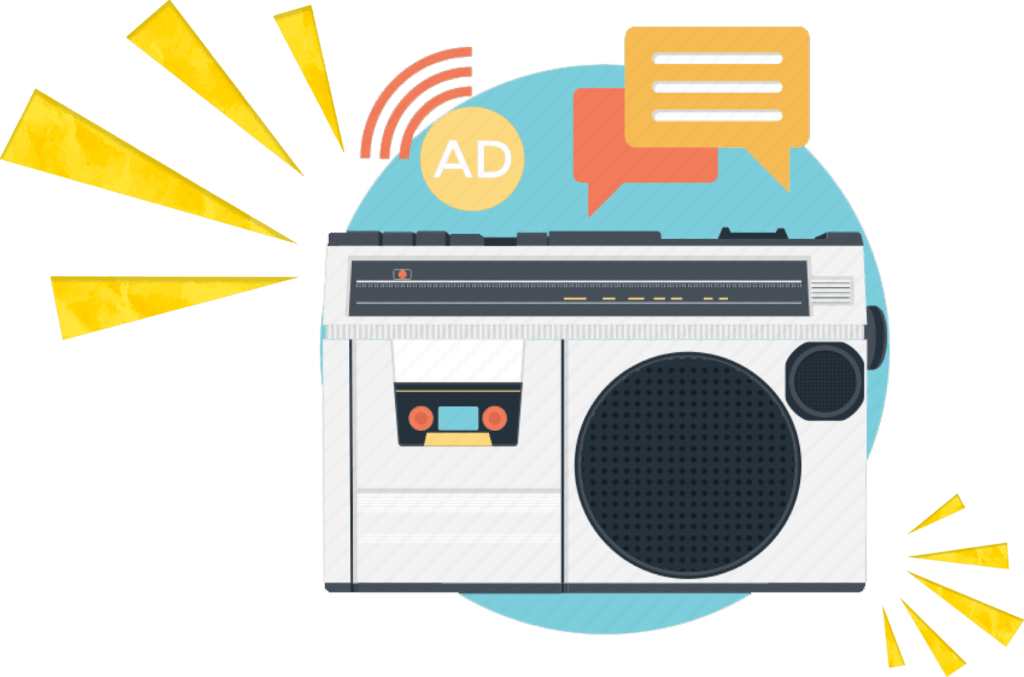

Some marketers are paying for the same services on the radio as they do on television when advertising is shown during the shows themselves. Radio marketing is also known by its more common name, advertising over the radio.
Therefore, radio advertising is the process of promoting your goods or services by purchasing commercial time on a radio broadcast. This can be done in order to reach a wider audience. These snippets are typically referred to as spots when working in the radio industry. To put it another way, marketers will pay commercial radio stations for air time in order to promote their products. People who are listening to the radio at this time will hear a message from an advertiser thanks to this particular commercial break.
Sponsorships
Sponsorship advertising is commonly incorporated into various types of radio shows by most radio stations. These broadcasts can cover a wide range of themes, including sports, traffic, weather, fashion, and so on.
The segment’s sponsorship advertisements will largely display at the show’s opening and end. Furthermore, the advertisements may appear during commercial breaks.
Jingle ads
There isn’t a lot of room for disagreement when it comes to the fundamental relationship that exists between music and memory. Jingle advertisements have shown to be fairly effective over the course of many years when it comes to drawing attention to a commercial. They are brief and can easily be remembered.
Live reads
Popular radio hosts usually have a sizable following. Support from a well-known presenter can aid in the development of your brand’s relationship with the local audience, resulting in increased loyalty over time. In most cases, hosts advertise adverts in a live-read format. In comparison to other pre-recorded commercials made during commercial breaks, an announcement will seem less like a commercial and more casual.




The image or identity of a business, as well as how it is presented to customers, is referred to as corporate branding. The values, brand voice, and message of a business are often represented by its brand. Marketing professionals frequently create corporate brands to represent how they want the company to be seen.
- Find out the purpose behind your brand
- Research competitor brands in your niche
- Decide who your brand’s target audience is.
- Create a brand mission and vision
- Outline the primary features and benefits that your business offers.
- Create your own unique brand voice.
- Allow your brand’s personality to shine through.
- Create a brand story and messaging
Corporate branding helps customers to connect with the business and recognize a variety of product offerings throughout time. Good branding minimizes the need for large marketing. The customer has a pre-determined idea of the product’s quality, reliability, and purpose, effective branding reduces the need for large marketing initiatives for each new product.
The corporate identity uses the logo, color, fonts, and other graphical components to communicate the brand’s core messages and values. A brand must provide customers with solutions while also creating confidence, and credibility to convert leads.
Corporate branding is a company-wide approach that tells what a company stand offers to its customers. Whereas, product branding is limited to a product.


Some marketers are paying for the same services on the radio as they do on television when advertising is shown during the shows themselves. Radio marketing is also known by its more common name, advertising over the radio.
Therefore, radio advertising is the process of promoting your goods or services by purchasing commercial time on a radio broadcast. This can be done in order to reach a wider audience. These snippets are typically referred to as spots when working in the radio industry. To put it another way, marketers will pay commercial radio stations for air time in order to promote their products. People who are listening to the radio at this time will hear a message from an advertiser thanks to this particular commercial break.
Sponsorships
Sponsorship advertising is commonly incorporated into various types of radio shows by most radio stations. These broadcasts can cover a wide range of themes, including sports, traffic, weather, fashion, and so on.
The segment’s sponsorship advertisements will largely display at the show’s opening and end. Furthermore, the advertisements may appear during commercial breaks.
Jingle ads
There isn’t a lot of room for disagreement when it comes to the fundamental relationship that exists between music and memory. Jingle advertisements have shown to be fairly effective over the course of many years when it comes to drawing attention to a commercial. They are brief and can easily be remembered.
Live reads
Popular radio hosts usually have a sizable following. Support from a well-known presenter can aid in the development of your brand’s relationship with the local audience, resulting in increased loyalty over time. In most cases, hosts advertise adverts in a live-read format. In comparison to other pre-recorded commercials made during commercial breaks, an announcement will seem less like a commercial and more casual.






The image or identity of a business, as well as how it is presented to customers, is referred to as corporate branding. The values, brand voice, and message of a business are often represented by its brand. Marketing professionals frequently create corporate brands to represent how they want the company to be seen.
- Find out the purpose behind your brand
- Research competitor brands in your niche
- Decide who your brand’s target audience is.
- Create a brand mission and vision
- Outline the primary features and benefits that your business offers.
- Create your own unique brand voice.
- Allow your brand’s personality to shine through.
- Create a brand story and messaging
Corporate branding helps customers to connect with the business and recognize a variety of product offerings throughout time. Good branding minimizes the need for large marketing. The customer has a pre-determined idea of the product’s quality, reliability, and purpose, effective branding reduces the need for large marketing initiatives for each new product.
The corporate identity uses the logo, color, fonts, and other graphical components to communicate the brand’s core messages and values. A brand must provide customers with solutions while also creating confidence, and credibility to convert leads.
Corporate branding is a company-wide approach that tells what a company stand offers to its customers. Whereas, product branding is limited to a product.









The image or identity of a business, as well as how it is presented to customers, is referred to as corporate branding. The values, brand voice, and message of a business are often represented by its brand. Marketing professionals frequently create corporate brands to represent how they want the company to be seen.
- Find out the purpose behind your brand
- Research competitor brands in your niche
- Decide who your brand’s target audience is.
- Create a brand mission and vision
- Outline the primary features and benefits that your business offers.
- Create your own unique brand voice.
- Allow your brand’s personality to shine through.
- Create a brand story and messaging
Corporate branding helps customers to connect with the business and recognize a variety of product offerings throughout time. Good branding minimizes the need for large marketing. The customer has a pre-determined idea of the product’s quality, reliability, and purpose, effective branding reduces the need for large marketing initiatives for each new product.
The corporate identity uses the logo, color, fonts, and other graphical components to communicate the brand’s core messages and values. A brand must provide customers with solutions while also creating confidence, and credibility to convert leads.
Corporate branding is a company-wide approach that tells what a company stand offers to its customers. Whereas, product branding is limited to a product.


